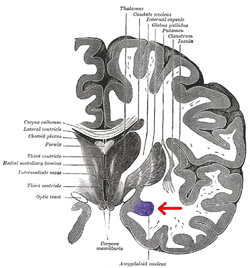Basolateral amygdala
| Basolateral amygdala | |
|---|---|
 Coronal section of brain through intermediate mass of third ventricle. Amygdala is shown in purple. | |
| Details | |
| Part of | Amygdala |
| Identifiers | |
| Acronym(s) | BL |
| NeuroNames | 244 |
| NeuroLex ID | BIRNLEX:2679 |
| FMA | 84609 |
| Anatomical terms of neuroanatomy | |
The basolateral amygdala, or basolateral complex, consists of the lateral, basal and accessory-basal nuclei of the
Function
The amygdala has several different nuclei and internal pathways; the basolateral complex (or basolateral amygdala), the central nucleus, and the cortical nucleus are the most well-known. Each of these has a unique function and purpose within the amygdala.
Fear response
The basolateral amygdala and
An important process that occurs in basolateral amygdala is
Pain memory
Distinct ensembles of neurons within the basolateral amygdala play a role in encoding associative memories and the response to painful stimuli.[12] The ensemble activated in response to noxious stimuli are of particular interest for targeting treatments of chronic pain and cold allodynia. When neurons within this ensemble are silenced in a rodent model the affective component of pain is essentially erased, while a robust reflex response is maintained.[13] This is thought to implicate the basolateral amygdala in assigning a “pain tag” to valence information which may intrinsically encode that there is a priority to engage in pain-protective behaviors.
References
- PMID 26658874.
- PMID 32277045.
- PMID 29593511.
- PMID 32945260.
- ^ Baars BJ, Gage NM (2010). Cognition, Brain, and Consciousness: introduction to cognitive neuroscience (second ed.). Burlington MA: Academic Press.
- PMID 24312025.
- PMID 26323245.
Considerable evidence indicates that accumbens DA is important for Pavlovian approach and Pavlovian-to-instrumental transfer [(PIT)] ... PIT is a behavioral process that reflects the impact of Pavlovian-conditioned stimuli (CS) on instrumental responding. For example, presentation of a Pavlovian CS paired with food can increase output of food-reinforced instrumental behaviors, such as lever pressing. Outcome-specific PIT occurs when the Pavlovian unconditioned stimulus (US) and the instrumental reinforcer are the same stimulus, whereas general PIT is said to occur when the Pavlovian US and the reinforcer are different. ... More recent evidence indicates that accumbens core and shell appear to mediate different aspects of PIT; shell lesions and inactivation reduced outcome-specific PIT, while core lesions and inactivation suppressed general PIT (Corbit and Balleine 2011). These core versus shell differences are likely due to the different anatomical inputs and pallidal outputs associated with these accumbens subregions (Root et al. 2015). These results led Corbit and Balleine (2011) to suggest that accumbens core mediates the general excitatory effects of reward-related cues. PIT provides a fundamental behavioral process by which conditioned stimuli can exert activating effects upon instrumental responding
- ^ Breedlove S, Watson N (2013). Biological Psychology: an introduction to behavioral cognitive, and clinical neuroscience (Seventh ed.). Sunderland: MA: Sinauer Associates, Inc.
- ^ Smith C, Kirby L (2001). "Toward delivering on the promise of appraisal theory.". In Scherer KR, Schorr A, Johnstone T (eds.). Apraisal processes in emotion: Theory, methods, research. Oxford, UK: Oxford University Press.
- ^ PMID 24478341.
- PMID 10816588.
- PMID 28329757.
- PMID 30655440.
